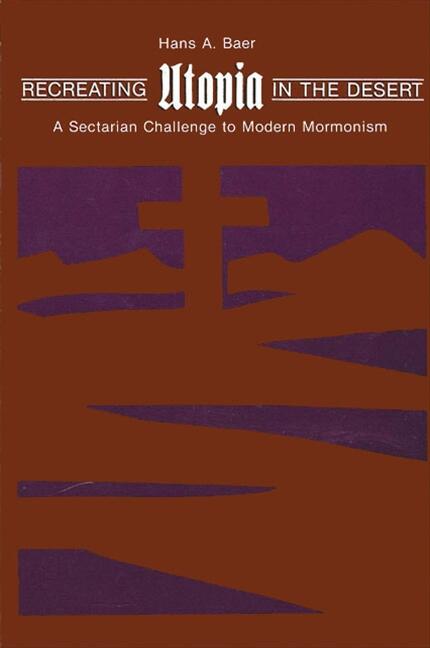Articles/Essays – Volume 23, No. 2
Mormon Splinter Groups | Hans A. Baer, Recreating Utopia in the Desert: A Sectarian Challenge to Modern Mormonism
In this ethnography of a Mormon splinter group, Hans Baer postulates that Mormonism’s capacity to produce schisms is a two-fold reflection of itself. As Mor monism entered the mainstream in this century, it abandoned its poorer members, who, citing the Church’s communitarian origins, founded revitalized versions of the faith that aided them in their deprivation. So, as Mormonism was to its poor adherents from 1830 to 1890, the new Mormonisms are to the equally poor between 1930 and 1970. Thus, Baer argues that the search for a restored early church is neither a social nor a historical quest, nor a reform, but the kind of schism to be expected as an upwardly mobile, class-tied institution marginalizes a portion of its own population. Modern Mormonism created Mormonisms just as the Federal Era created early Mormonism out of Protestant Christianity and widespread poverty.
Baer, one anthropologist studying a tiny, distant, quasi-Mormon group, places within this context Maurice Glendenning’s (founder of the Aaronic Order) conversations with the Angel Elias, the increasing conservatism of the Mormon church in the twentieth century, the long history of schism within Mormonism, the search for communitarian ways of life, and much of the American contemporary communal movement. Baer worked ten years on his extremely thorough book, and the time shows. In addition to getting to know his subject well, Baer also read and reworked much of the important literature on religious conversion, revitalization movements, churches and sects, social deprivation, Utopias, communes, and modern Mormon scholarship. He also took chances with himself and used his own vulnerability to teach. Any modern ethnography should tell us about its topic, its author, and ourselves. This book appears quite ordinary, but no ordinary effort went into it.
The Levites or the Aaronic Order were founded in the 1930s by Maurice Glendenning, a convert to Mormonism, who received revelations from the Angel Elias and established in the 1940s in the Utah desert common-property communities that continue to this day. Branches established in Salt Lake City are not communal. The order was never polygynous, does not proselytize, and never numbered more than a few hundred members. Early members were Latter-day Saints; Levites exist within a largely Mormon context, and although they have become more akin to evangelical Protestants and less formally Mormon, Baer is correct to analyze them in the Great Basin Mormon centered context.
Baer establishes the deprived eco nomic background of the members of the Aaronic Order over three generations. He shows how the top-heavy hierarchy within the tiny order places marginal people on top in their own world. And he also shows how Glendenning’s insecure environment led him to see his dreams and fantasies as visions and depictions of a cure for marginality. Baer chooses not to analyze Glendenning’s revelations as wished-for resolutions of struggles with authority, but rather uses them as psychobiography, revealing a relatively ordinary man, likeable enough, struggling with the immense problems of the first half of this century: poverty, insecurity, economic depression, powerlessness, rootlessness, and poor education. In this environment, the new religion flourished. Baer describes theology, practical philosophy, and everyday thinking of the Levites, some rooted in Mormonism, some about the second coming, and some about Jesus as a savior.
Baer’s volume makes apparent the threefold dilemma currently facing Mormon scholars. First, thanks to the historical community, we know much about nineteenth-century Mormonism, but information is more scarce about the twentieth, particularly about the central Church in Salt Lake City and the people and communities practicing plural marriage. Second, anthropologists like Baer carry on where historians must leave their task. We look at the small, living communities, but we have not gotten inside the bureaucratic culture nor into the communities practicing plural marriage. This is not for lack of effort, but lack of access. Third, because historians do not study the present directly and anthropologists are not privy to the very powerful or the very private among the living, we are left to study Mormonism indirectly by looking at its past or its living margins. Supposedly we can see the center, our real concern, by reflection or inference. Supposedly also, particularly for social scientists, Mormonism is itself a way to see United States society more clearly. This is in fact the oldest rationale for studying Mormonism.
The threefold dilemma we see reflected in Baer’s volume is the failure of historians and anthropologists to see into and analyze the core of the Church. Modern living Mormonism is fully American; it is not a vision of where America will be. It is America. Neither historians nor anthropologists have yet dealt with this. Furthermore, the tools we are now using to study Mormonism may not be the best for describing the internal workings of late twentieth-century phenomena. Rather, the tools for seeing our society are powerful and dangerous and largely untried in Mormon scholarship: psycho analysis, the various Marxisms, critical theory of the Frankfurt School, and interpretivist theory in literary criticism. Baer tries some of these; other scholars are trying others. But, it seems to me, these are the very tools that can help us address our dilemma and learn to know ourselves.
Recreating Utopia in the Desert: A Sectarian Challenge to Modern Kiormonism by Hans A. Baer (Albany, New York: State University of New York Press, 1988), 225 pp., paper $14.95, cloth $44.50.


 Back to full Issue
Back to full Issue

